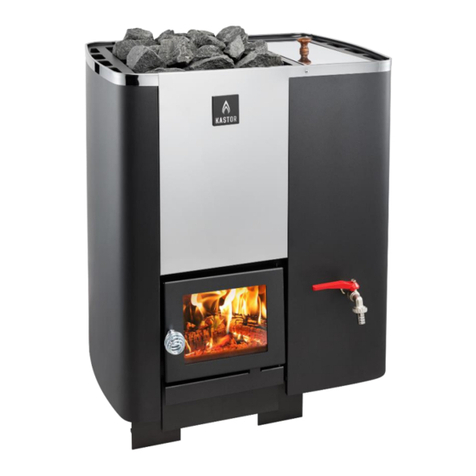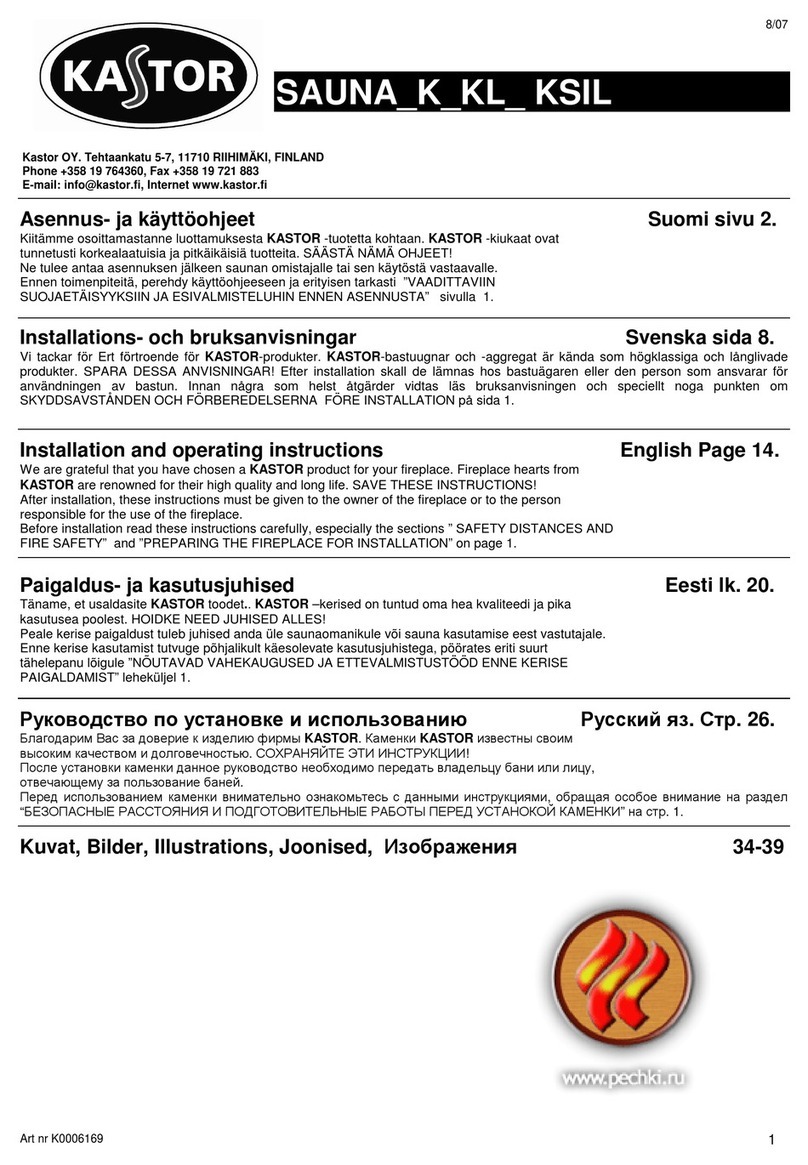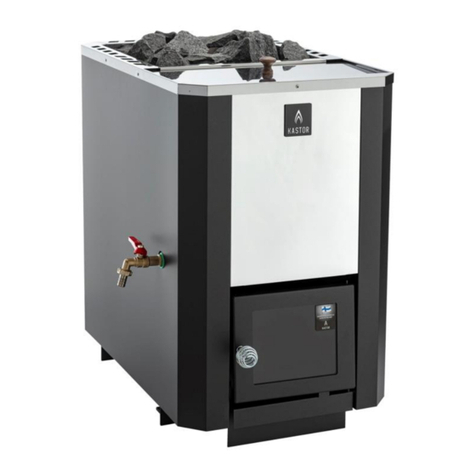8/07
2.3. SAFETY DISTANCES AND SAFEGUARDS
Failure to observe safety distances causes a risk of fire!
Sauna heaters are classified as hot units with a maximum surface temperature of 350oC (662°F). The
minimum distance from the rear and the sides of the heater to any combustible material or
surface is 500 mm (20”); from the front of the heater 1,000 mm (40”), and from the top of the
heater 1,200 mm (48”).
A 50% reduction in the safety distances is achieved with a single protective sheet and a 75% reduction
with a double sheet. Such a sheet may consist of 1 mm (3/64”) thick metal sheet or 7 mm (9/32”)
thick fiber-reinforced cement board (no paper-faced or similar gypsum board). A ventilation gap
of 30 mm (1 ¼”) must be left between the wall and the protective sheeting. Additionally, the
sheeting must be clear of the floor and ceiling. With heaters fitted with a hot water tank, the safety
distance to combustible material on the side of the tank is 150 mm (6”). If the floor of the sauna in
front of the heater is made of combustible material, the area to be protected should extend 100
mm to both sides of the fire door and to a minimum distance of 400 mm (16”) forward. The
protective sheeting must consist of a metal sheet with a minimum thickness of 1 mm. See also
section 2.4.
A 50 mm (2”) clearance to a brick wall is required on the sides and in the rear of the heater.
The safety distances of the connecting pipes between the heater and the chimney are 1,000 mm (40”)
in the lateral direction and 1,200 mm (48”) in the vertical direction. Safety distances can be
reduced using similar protective sheeting as with the heater itself. The minimum safety distance
of Kastor chimneys to combustible materials is 100 mm (4”), provided that the insulated part of
the chimney extends down to a height of 400 mm (16”) below the ceiling.
If you are uncertain, consult the local building authorities.
Heaters with an extended fire door section may only be installed through a wall made of
incombustible material (brick, concrete, etc.). Then, the incombustible material must enclose
the extended fire door as shown in Fig. 5. If the floor in front of the fire door is made of
combustible material, the area to be protected should extend 100 mm (4”) to both sides of the fire
door and to a minimum distance of 400 mm (16”) forward. The protective sheeting must consist
of a metal sheet with a minimum thickness of 1 mm (3/64”). See also section 2.4.
2.4. INSTALLATION BASE
Install the sauna heater on a level, firm and stable fire-insulated base, The front feet of the heater
include openings for adjusting screws that can be used to level the heater on a sloping floor. The
screws are found in the accessory bag inside the heater. Insert the screws and level the heater.
The best base is made of cast concrete. Installation on a tiled floor is not recommended
because damp proof courses and tile adhesives contain materials sensitive to heat. Please note
that light-coloured wooden floors are easily soiled by the ash and other impurities associated with
wood-fired heaters.
With proper fire insulation, the heater can also be installed on a wooden floor. Acceptable insulation is
usually provided by a 60 mm (2 7/16”) thick cast concrete slab with a smooth finish and slight
forward slope (ensure moisture removal). The fire insulation on the floor must extend a distance
of 400 mm (16”) beyond the front of the heater, 250 mm (10”) on both sides and 250 mm (10”) in
the rear, or up to an insulated wall on the side and in the rear.
– Heaters with an extended fire door section
The floor of the steam room and the room in which the fire door is located must be at the same level.
Alternatively, the floor of the room with the fire door may be lower that that of the steam room but
never higher!
The heater, the extended fire door section included, is installed on a level, firm and stable fire-
insulated base, preferably made of cast concrete. If the floor of the room in which the fire
door is located is made of a combustible material, there must be a layer of incombustible fire
insulation with a minimum thickness of 60 mm (2 7/16”) underneath the extended fire door
section (such as cast concrete or brickwork). As far as fire insulation on the fire door side is
concerned, also consider the instructions given in section 2.3.
With proper fire insulation, a heater with an extended fire door section can also be installed on
a wooden floor. However, the partitioning wall must then be made of incombustible material
(brickwork, concrete, etc.). Both for the steam room and the room where the fire door is located,
acceptable insulation is usually provided by a 60 mm (2 7/16”) thick cast concrete slab (ensure
4211-60 Kastor K-007, KL16VE 3 3/25/11
Rev. 1
































